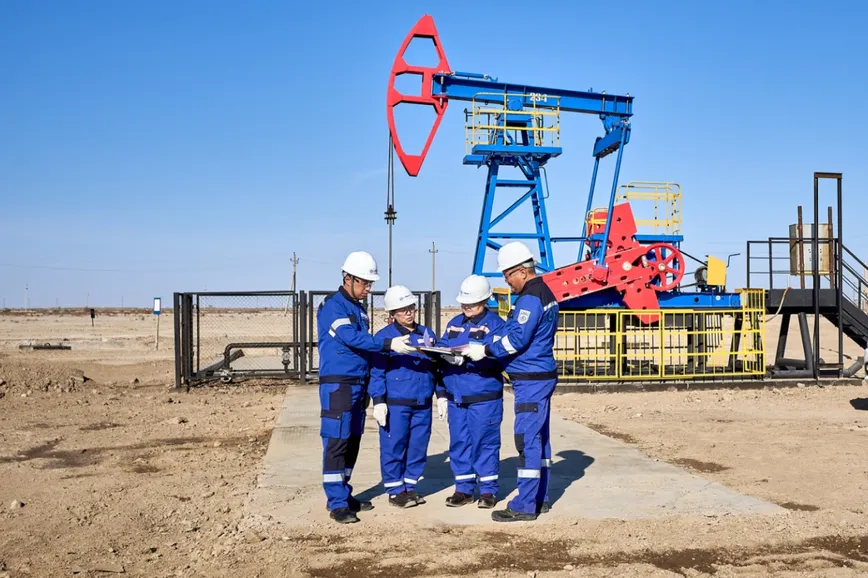On April 30, the Ministry of Energy gave an update on national subsurface asset management, emphasizing eleven key points, QazMonitor reports citing the Ministry’s press service.
Improved Model Contract: Introduced in the legislation on December 29, 2022, the IMC aims to raise funds for developing complex projects that investors may shy away from due to their high capital requirements and insufficient geological data. Since 2023, five contracts totaling $9 billion have been signed under the new contract.
New contracts were signed for several fields, including Kalamkas-Sea and Khazar (with reserves of 238.1 million tons), Karaton Podsolevoy (with reserves of 353.5 million tons), East Urikhtau (with reserves of 24 million tons and 12 billion cubic meters), North Maybulak (with reserves of 19.7 million tons), and Yuzhnoye Pridorozhnoye (with reserves of 15.2 billion cubic meters). Additionally, contracts were signed for Ortalyk, Asa, Kendyrlyk, Tamgalytar, and Oppak, with an overall reserve assessment of 138 billion cubic meters.
These projects have various benefits, including tax relief on property, separate treatment of capital expenses for tax purposes, and smooth transition from exploration to production phases, among others.
Streamlined government approval: The time needed to start geological exploration at fields has been cut to eight to ten months. Changes to the notification process for surveys, environmental assessment following project document review, and the removal of economic assessment have streamlined approval by government agencies.
E-auctioning process simplified: Recent legislative changes have broadened competition in e-auctions for subsurface use rights, leading to an increase in signature bonuses paid to the budget from ₸12.8 billion (as of April 30, 2024, $28.9 million) to ₸32 billion ($72.4 million).
Plans for depleted fields: In 2023, rules were introduced for investing in fields in their late stages. This year, amendments to the Tax Code are expected to allow 24 out of 307 oil fields to apply an alternative tax. This reform could lead to annual exploration investments of up to ₸200 billion ($452.9 million), a 60 million ton increase in oil production by 2045, and the preservation of current jobs.
Development of new fields: In 2023, 30 hydrocarbon fields transitioned from exploration to production. They added 115.4 million tons of oil and 25.5 billion cubic meters of gas to the national recoverable reserves. Commercial production in these fields will begin within three years of development. Notable oil reserves include Akzhar East (51.4 million tons), Kul-Bas (17.3 million tons), North Maybulak (5.9 million tons), and Bestobe (5 million tons). Significant gas reserves include Kubasay (6.6 billion cubic meters) and Ayrakty (5.9 billion cubic meters).
Subsoil users conduct detailed field appraisals, including high-resolution seismic surveys, reviewing earlier seismic data, appraisal well drilling, and revising geophysical studies. These efforts have led to increased geological oil reserves, such as 88.5 million tons at the Uzen field, 18.5 million tons at the Kalamkas field, 9.8 million tons at the Karazhanbas field, and 6.8 million tons at the Asar field, among others.
New gas projects launched: In 2023, gas production began at the Rozhkovskoye field (providing 1 billion cubic meters per year), South Aksay field (over 100 million cubic meters per year for Kyzylorda city), and Anabay field (200 million cubic meters per year). In the near future, Central Urikhtau, Prorva West, and Kalamkas fields, with recoverable gas reserves exceeding 69 billion cubic meters, are set to be launched.
Local procurement by subsurface users: In total, purchases of goods, services, and works amounted to ₸6.7 trillion ($15.172 billion). Of this, 61%, or ₸4.1 trillion ($9.284 billion), came from local manufacturers. This includes ₸2.3 trillion ($5.208 billion) for works, ₸1.4 trillion ($3.170 billion) for services, and ₸0.4 trillion ($905 million) for goods.
The Ministry revised procurement rules, prioritizing local producers through single-source method (if only one producer is available) or tender (if multiple producers exist).
New oil and gas facilities launched: In 2023, five new production facilities were introduced in collaboration with global manufacturers like WIKA from Germany for pressure and temperature equipment, Honeywell from the US for gas detectors and control system cabinets, PetrolValves from Italy for valves, Kazakh company Sigma Solutions for explosion-proof junction boxes, and Emerson from the US for pressure sensors.
Exploration investments: In 2023, total investments reached ₸7.4 trillion ($16.757 billion), with ₸152.4 billion ($345 million) dedicated to exploration.
Contract termination: In 2022, the Ministry terminated 18 contracts, and in 2023, 22 contracts were terminated after auditing subsurface areas held by users for an extended period without meeting contract obligations. As part of the audit, fines and debts totaling ₸3.1 billion ($7.020 million) have been paid to date.
Plans for new exploration wells: Subsurface users aim to drill over 80 new sites in 2024. This includes starting drilling at the Turgai Paleozoic for a deep well reaching 5,500 meters to uncover potential oil and gas reserves. Work will also commence at the Abay block in the Kazakhstan sector of the Caspian Sea. The users also work to start drilling at several sites – Karaton (5,500m deep), Aday block (6,900m deep), Maksat structure (6,200m deep), Say-Utes site (5,250m deep), and Block A (6,900m deep).
